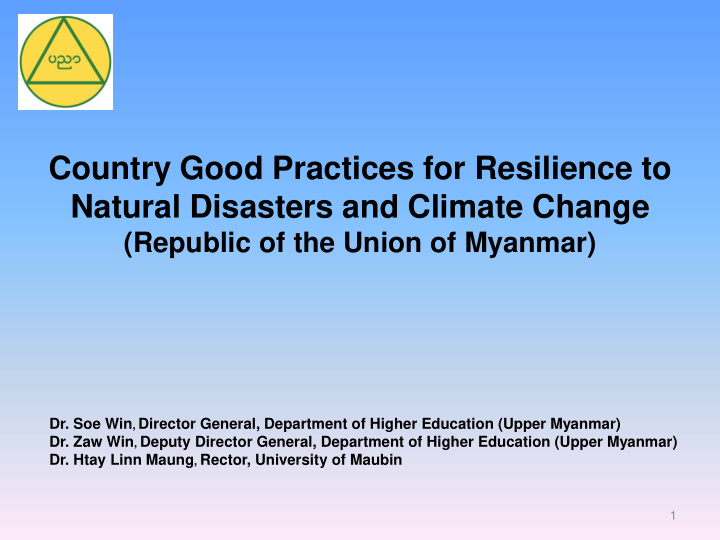



Country Good Practices for Resilience to Natural Disasters and Climate Change (Republic of the Union of Myanmar) Dr. Soe Win , Director General, Department of Higher Education (Upper Myanmar) Dr. Zaw Win , Deputy Director General, Department of Higher Education (Upper Myanmar) Dr. Htay Linn Maung , Rector, University of Maubin 1
Presentation Outline • Rationale for mainstreaming DRR in education in Myanmar • Policy and Legal framework supporting DRR mainstreaming in education • Comprehensive Education Sector Reform • Achievements of the Ministry of Education in mainstreaming DRR in education • Challenges • Opportunities and ways forward 2
Why Mainstream DRR in Education in Myanmar? • Myanmar is exposed to multiple natural hazards e.g. cyclone, storm surge, floods, fires, tsunamis • Cyclone Nargis in 2008 destroyed between 50 and 60% of educational facilities in affected areas, with damage to the education sector totaling up to USD 116 Million • Two years later, cyclone Giri damaged over 350 schools with damage to the education sector totaling USD 1.26 Million School safety protects children’s lives and Myanmar’s investment against its goal of Education for All 3
Policy Framework on DRM and DRR in Education • Hyogo Framework for Action • ASEAN Agreement on Disaster Management and Emergency Response (AADMER) and ASEAN Safe School Initiative (ASSI) under Work Program Phase 2 • Myanmar Environmental Conservation Law (2013) and National Adaptation Programme of Action (2012) • Disaster Management Law (2013) and Standing Orders on Disasters (2012) • Myanmar Action Plan for Disaster Risk Reduction (MAPDRR) adopted in 2012 (school disaster preparedness, DRR mainstreaming in education and training) • “Guidance on Mainstreaming DRR in education” by Ministry of Social Welfare and Ministry of Education, 2009 4
5
National Mechanism for Disaster Mgt • The National Disaster Preparedness Central Committee was reformed in May 2013 with the chairmanship of Vice President • The National Disaster Preparedness Working Group, chaired by Minister of Social Welfare, Relief and Resettlement. • 10 sub-committees (Information and Education; Emergency Communication; Search and Rescue; Information of Losses and Emergency Assistance; Clearing Ways and Transportation; Mitigation and Establishing of Emergency Shelter; Health; Assessment of Losses; Rehabilitation; Security) 6
Comprehensive Education Sector Reform • CESR is a coherent three-phased approach initiated in 2012 to reform all aspects of the education sector: – Phase 1: assessment and in-depth analysis of key areas (completed) – Phase 2: development of key policies and budget (will be completed at the end of 2014) – Phase 3: National Education Sector Plan (5-year) “CESR Assessment Report recommends to set the policy framework for implementation based on child friendly schools dimensions: inclusiveness, effectiveness, health, safety & protection, gender friendliness and participation” 7
Achievements of Myanmar: Safe Learning Facilities MOE Safe School Design Manual Supported by an increase in budget (2012) allocation per classroom 8
Achievements of Myanmar: Safe Learning Facilities Before After Most schools also serve as emergency shelters 9
Achievements of Myanmar: School Disaster Management • The DRR Resource Pack was developed by MOE in 2009 and has been distributed in all schools at regular intervals 10
Achievements of Myanmar: School Disaster Management Content of DRR Resource Pack: • Risk assessment • School disaster management plans • Drills and practices • Teaching and learning materials 11
Achievements of Myanmar: School Disaster Management With support from NGOs, many schools have preparedness plans in place and practice regularly through drills 12
Achievements of Myanmar: Teachers’ Training Teachers’ Training Modules developed by MOE with support from UNESCO Eight modules covering all aspects of DRR in education in Myanmar 13
Achievements of Myanmar: Teachers’ Training More than 10,000 teachers have been trained through teacher colleges and in-service training in the most hazard-prone areas of the country 14
Achievements of Myanmar: DRR/CCA in the Curriculum • Formal Life Skills Curriculum Level Grade Lesson Topic Primary Grade 5 Caution in Emergencies (floods, tsunami, earthquake, fire) Environmental Conservation Lower Secondary Grade 6 Emergency! It is flooding! Grade 7 Disaster Preparedness (family plan, emergency kit, evacuation map) Grade 8 Earthquake, landslides Safety in case of fire, coservation • Formal Curriculum: DRR in other subjects Level Grade Lesson Topic Subject Lower Secondary Grade 6 Thunderstorm General Science Grade 8 Storm General Science Upper Secondary Grade 10 Earthquake English Grade 11 Earth Surface Processes Geography 15
Achievements of Myanmar: DRR in the Curriculum • A few examples of co-curricular materials (formal and non formal) 16
Challenges in mainstreaming DRR • DRR and comprehensive school safety not reflected in the education policy framework yet • Many competing demands are placed on the education sector reform • Budget allocation for education is low in general and within that, almost non-existent for DRR-related activities 17
Challenges in mainstreaming DRR • Limited technical capacity within MOE and weak coordination with the Relief and Resettlement Department under the Ministry of Social Welfare, Relief and Resettlement • School-based disaster management activities are not sustainable – supported by NGOs but not led by MOE or institutionalized within education plans 18
Opportunities and Ways forward • Political reform in Myanmar: improved ability to influence parliamentary processes and budgeting • Decentralization process: closer to population’s needs in spite of capacity gaps • Education sector reform: possibility to advocate for the inclusion of comprehensive school safety in the National Education Sector Plan, the Basic Education Law, the Teachers Education Law, and the School Quality Assessment Framework 19
Opportunities and Ways forward • Development of national safe school construction guidelines based on ASEAN examples • Strong multi-stakeholder platform active since 2008 co-convened by UNESCO and MOE: Disaster Preparedness and Response Education Working Group (DPRE WG) • ASEAN learning and sharing on DRR and school safety under ASEAN Safe School Initiative • National ceasefire and opportunity to engage non state actors on school safety • High donor interest for education in Myanmar 20
21
Recommend
More recommend